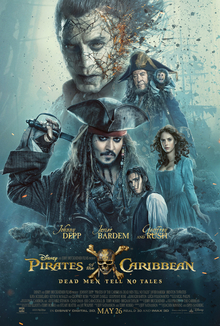Hollywood Versus the Real History of Pirates
 Films often take creative license to deviate from historical fact, and Pirates of the Caribbean: Dead Men Tell No Tales follows in this tradition. Often, this creative license simplifies complicated realities. Below are four ways the Pirates of the Caribbean films oversimplify the complicated and very rational real-world of Caribbean piracy during the so-called Golden Age (1650 to about 1730).
Films often take creative license to deviate from historical fact, and Pirates of the Caribbean: Dead Men Tell No Tales follows in this tradition. Often, this creative license simplifies complicated realities. Below are four ways the Pirates of the Caribbean films oversimplify the complicated and very rational real-world of Caribbean piracy during the so-called Golden Age (1650 to about 1730).
First, real-world pirates rarely used vessels large enough to be called “ships”. During the age of “fighting” sail, the term ship was reserved for vessels with three or more masts. Pirates needed fast and agile boats that could overtake their prey and escape quickly. Thus, most pirates used schooners with one mast, rigged with a substantial amount of sail to maximize speed. They were also shallow-draft boats to allow for quick escape into lagoons and rivers along the island coasts to evade bigger regular naval ships.
In contrast, the ships in Dead Men Tell No Tales are large and bulky, Galleon-style ships with several rows of cannon—historically accurate for regular navy ships but not pirate ships of the period. Stacking gun decks created significant fire power, an advantage based on the fleet battle tactics of the time. By 1600, most navies engaged in sea battle by having heavily armed warships sail past each in straight lines. These “ships of the line”) were heavy and slow. They were also not particularly effective in chasing down pirates using vessels retrofitted for quick search, capture, and escape tactics.
Larger ships, however, are much better suited to the visual storytelling of film. Large ships convey the visual image of power. Screenwriters can fall back on the fantasy elements of the Pirates of the Caribbean films to create plausibility. On a practical level, choreographing, filming or creating CGI effects for chases and fights, such as Jack Sparrow’s evasion of imminent death by jumping from cannon to cannon between the ships, is easier on large surfaces. (The closeness of battle depicted in the films, in fact, was historically common, one reason some warships had almost as many marines as sailors on board.)
Second, real-world pirate vessels were packed with pirates. The goal was to overwhelm their targets—usually merchant ships with 8-12 sailors and lightly armed—to convince them to surrender without a fight. Fighting was costly and significantly increased risks. So, the pirate strategy was to intimidate. A 70-foot sloop might have a hundred or more pirates ready to board a hapless merchant ship. Warships of the size and scale of the Flying Dutchman, or the Dying Gull in Dead Men Tell Now Tales (or the three-decker Endeavor in At World’s End), would easily have carried crews of 300 to 500 in the regular navy. In the films, CGI effects create large numbers of pirates, but their numbers don’t approach this scale. One reason is likely because audiences would find it impossible to separate the key characters from the swarms involved in hand-to-hand combat in a properly scaled fight.
Third, violence was largely a tactic, not a psychopathic trait, for real pirates. While some pirate captains were known for their brutality, the violence was often calculated to instill mortal terror and fear in the sailors, officers, and passengers. Even the notorious Blackbeard used lit fuses in his beard mainly to frighten his targets and create a supernatural and sociopathic reputation to make pirating more efficient. This branding strategy was quite effective. In contrast, the Pirates of the Caribbean movies depict pirate captains as emotional rogues, inherently heartless and villainous. Indeed, Geoffrey Rush was chosen to play Captain Hector Barbossa because in part he could play the with the right amount of villainy.
Fourth, pirate crews elected their captains, could (and sometimes did) change captains in mid-course, and used written Articles to establish a mutually beneficial and “just” contractual relationship among their members. The did not fight over the booty. The adopted pre-arranged rules to ensure the treasure was divvied up fairly. Captains were expected to uphold and be bound by the Articles. As a result, in the real world of the Golden Age, pirate captains tended to be less tyrannical than regular navy officers who often commanded sailors forced (pressed) into service. They had to respect their crews and prove their worth to keep their job.
The political economy of real-world piracy during the Golden Age was remarkably rational. Pirates estimated risks, costs, and benefits, and these calculations motivated their choices of tactics and targets. Economist Peter Leeson provides an excellent analysis of these elements of Caribbean piracy in The Invisible Hook: The Hidden Economics of Pirates (and his podcast at UndertheCrossbones.com). Other sources include David Cordingly’s classic Under the Black Flag: The Romance and Reality of Life Among the Pirates.
Pirates of the Caribbean: Dead Men Tell No Tales raked in nearly $80 million during its opening weekend, boding well for the films future as a global blockbuster. While critics are lukewarm on the fifth installment (see my review here), the film fits squarely within the franchise’s conventions mixing drama, action, and comedy, so fans will likely keep revenue flowing at the box office. Unfortunately, one of the fall-outs of reinvigorating the pirate film genre appears to be sacrificing historical accuracy for dramatic effect.





